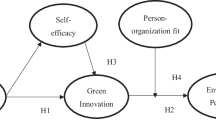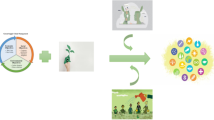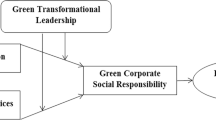Abstract
Faced with severe ecological problems and increasingly strict environmental regulations, green innovation is the preferred way for enterprises to cope with environmental pressure and gain market competitiveness under the condition of limited resources. From a perspective of the team and based on social information processing theory, this study constructs a moderated mediation model of the influence of team spiritual leadership on team green innovation performance with team task uncertainty and pro-environmental team climate as boundary conditions and green team identity as the mediator. The results shows that team spiritual leadership could promote team green innovation performance through enhancing team members’ green team identity (95%CI [0.0820, 0.3565]). When team task uncertainty is high, team members tend to seek help from team spiritual leadership, and the influence of team spiritual leadership on green team identity is stronger (β = 0.180, p < 0.01). When pro-environmental team climate is high, team members are more likely to transform the green visions, faith and altruistic love conveyed by spiritual leaders into green team identity, that is, the influence of spiritual leadership on green team identity is stronger (β = 0.176, p < 0.01). This paper reveals the spiritual dynamic mechanism of enhancing team green innovation performance, providing ideas for promoting sustainable development of enterprises.




Similar content being viewed by others
Data availability
The datasets generated during and/or analysed during the current study are available from the corresponding author on reasonable request.
References
Afsar, B., Badir, Y., & Kiani, U. S. (2016). Linking spiritual leadership and employee pro-environmental behavior: The influence of workplace spirituality, intrinsic motivation, and environmental passion. Journal of Environmental Psychology, 45, 79–88.
Ali, M., Aziz, S., Pham, T. N., Babalola, M. T., & Usman, M. (2020). A positive human health perspective on how spiritual leadership weaves its influence on employee safety performance: The role of harmonious safety passion. Safety Science, 131, 104923.
Bhave, D. P., Kramer, A., & Glomb, T. M. (2010). Work-family conflict in work groups: social information processing, support, and demographic dissimilarity. Journal of Applied Psychology, 95(1), 145.
Chang, C. H., & Chen, Y. S. (2013). Green organizational identity and green innovation. Management Decision, 51(5), 1056–1070.
Chen, Y. S. (2011). Green organizational identity: Sources and consequence. Management Decision, 49(3), 384–404.
Chen, Y. S., Lai, S. B., & Wen, C. T. (2006). The influence of green innovation performance on corporate advantage in Taiwan. Journal of Business Ethics, 67(4), 331–339.
Chen, Y. S., Chang, C. H., & Lin, Y. H. (2014). Green Transformational leadership and green performance: The mediation effects of green mindfulness and green self-efficacy. Sustainability, 6(10), 6604–6621.
Chen, J., Cheng, J., & Dai, S. (2017). Regional eco-innovation in China: An analysis of eco-innovation levels and influencing factors. Journal of Cleaner Production, 153, 1–14.
Chen, X., Yi, N., Zhang, L., & Li, D. (2018). Does institutional pressure foster corporate green innovation? Evidence from China’s top 100 companies. Journal of Cleaner Production, 188, 304–311.
Cheung, S. Y., Gong, Y., Wang, M., Zhou, L., & Shi, J. (2016). When and how does functional diversity influence team innovation? The mediating role of knowledge sharing and the moderation role of affect-based trust in a team. Human Relations, 69(7), 1507–1531.
Chuang, C. H., Jackson, S. E., & Jiang, Y. (2016). Can knowledge-intensive teamwork be managed? Examining the roles of HRM systems, leadership, and tacit knowledge. Journal of Management, 42(2), 524–554.
Dawson, J. F., & Richter, A. W. (2006). Probing three-way interactions in moderated multiple regression: development and application of a slope difference test. Journal of Applied Psychology, 91(4), 917–926.
Del Río, P., Peñasco, C., & Romero-Jordán, D. (2016). What drives eco-innovators? A critical review of the empirical literature based on econometric methods. Journal of Cleaner Production, 112, 2158–2170.
De Roeck, K., & Farooq, O. (2018). Corporate social responsibility and ethical leadership: Investigating their interactive effect on employees’ socially responsible behaviors. Journal of Business Ethics, 151(4), 923–939.
Dumont, J., Shen, J., & Deng, X. (2017). Effects of green HRM practices on employee workplace green behavior: The role of psychological green climate and employee green values. Human Resource Management, 56(4), 613–627.
Faraj, S., & Yan, A. (2009). Boundary work in knowledge teams. Journal of Applied Psychology, 94(3), 604–617.
Fry, L. W., Vitucci, S., & Cedillo, M. (2005). Spiritual leadership and army transformation: Theory, measurement, and establishing a baseline. The Leadership Quarterly, 16(5), 835–862.
Fry, L. W., Latham, J. R., Clinebell, S. K., & Krahnke, K. (2017). Spiritual leadership as a model for performance excellence: A study of Baldrige award recipients. Journal of Management, Spirituality & Religion, 14(1), 22–47.
García-Granero, E. M., Piedra-Muñoz, L., & Galdeano-Gómez, E. (2018). Eco-innovation measurement: A review of firm performance indicators. Journal of Cleaner Production, 191, 304–317.
Ghisetti, C., & Pontoni, F. (2015). Investigating policy and r&d effects on environmental innovation: a meta-analysis. Ecological Economics, 118, 57–66.
Graves, L. M., Sarkis, J., & Zhu, Q. (2013). How transformational leadership and employee motivation combine to predict employee proenvironmental behaviors in China. Journal of Environmental Psychology, 35, 81–91.
Hojnik, J., & Ruzzier, M. (2016). What drives eco-innovation? A review of an emerging literature. Environmental Innovation and Societal Transitions, 19, 31–41.
James, L. R., Demaree, R. G., & Wolf, G. (1993). rwg: an assessment of within-group interrater agreement. Journal of Applied Psychology, 78(2), 306–309.
Kim, S. S., & Vandenberghe, C. (2018). The moderating roles of perceived task interdependence and team size in transformational leadership’s relation to team identification: A dimensional analysis. Journal of Business and Psychology, 33(4), 509–527.
Kim, A., Kim, Y., Han, K., Jackson, S. E., & Ployhart, R. E. (2017). Multilevel influences on voluntary workplace green behavior: Individual differences, leader behavior, and coworker advocacy. Journal of Management, 43(5), 1335–1358.
Koseoglu, G., Liu, Y., & Shalley, C. E. (2017). Working with creative leaders: Exploring the relationship between supervisors’ and subordinates’ creativity. The Leadership Quarterly, 28(6), 798–811.
Li, M. E. I., & Choi, T. Y. (2009). Triads in services outsourcing: Bridge, bridge decay and bridge transfer. Journal of Supply Chain Management, 45(3), 27–39.
Li, D., Zhao, Y., Zhang, L., Chen, X., & Cao, C. (2018). Impact of quality management on green innovation. Journal of Cleaner Production, 170, 462–470.
Liao, Z., Xu, C. K., Cheng, H., & Dong, J. (2018). What drives environmental innovation? A content analysis of listed companies in China. Journal of Cleaner Production, 198, 1567–1573.
Ma, Y., Zhang, Q., & Yin, Q. (2021). Top management team faultlines, green technology innovation and firm financial performance. Journal of Environmental Management, 285, 112095.
Mael, F., & Ashforth, B. E. (1992). Alumni and their alma mater: a partial test of the reformulated model of organizational identification. Journal of Organizational Behavior, 13(2).
Mayer, D. M., Aquino, K., Greenbaum, R. L., & Kuenzi, M. (2012). Who displays ethical leadership, and why does it matter? An examination of antecedents and consequences of ethical leadership. Academy of Management Journal, 55(1), 151–171.
Norton, T. A., Zacher, H., & Ashkanasy, N. M. (2012). On the importance of pro-environmental organizational climate for employee green behavior. Industrial and Organizational Psychology, 5(4), 497–500.
Norton, T. A., Parker, S. L., Zacher, H., & Ashkanasy, N. M. (2015). Employee green behavior: A theoretical framework, multilevel review, and future research agenda. Organization & Environment, 28(1), 103–125.
Norton, T. A., Zacher, H., Parker, S. L., & Ashkanasy, N. M. (2017). Bridging the gap between green behavioral intentions and employee green behavior: The role of green psychological climate. Journal of Organizational Behavior, 38(7), 996–1015.
Prayag, G., Mills, H., Lee, C., & Soscia, I. (2020). Team identification, discrete emotions, satisfaction, and event attachment: A social identity perspective. Journal of Business Research, 112, 373–384.
Priesemuth, M., Schminke, M., Ambrose, M. L., & Folger, R. (2014). Abusive supervision climate: A multiple-mediation model of its impact on group outcomes. Academy of Management Journal, 57(5), 1513–1534.
Rapp, T. L., & Mathieu, J. E. (2019). Team and individual influences on members’ identification and performance per membership in multiple team membership arrangements. Journal of Applied Psychology, 104(3), 303–320.
Richter, A. W., West, M. A., Van Dick, R., & Dawson, J. F. (2006). Boundary spanners’ identification, intergroup contact, and effective intergroup relations. Academy of Management Journal, 49(6), 1252–1269.
Robertson, J. L., Carleton, E. (2017). Uncovering how and when environmental leadership affects employees voluntary pro-environmental behavior. Journal of Leadership & Organizational Studies, 25(2) 197-210.
Salancik, G. R., & Pfeffer, J. (1978). A social information processing approach to job attitudes and task design. Administrative Science Quarterly, 23, 224–253.
Schneider, B., Ehrhart, M. G., & Macey, W. H. (2013). Organizational climate and culture. Annual Review of Psychology, 64, 361–388.
Shafer, W. E. (2006). Social paradigms and attitudes toward environmental accountability. Journal of business Ethics, 65(2), 121–147.
Shoss, M. K. . (2017). Job insecurity: an integrative review and agenda for future research. Journal of Management, 43(20), 014920631769157.
Shrivastava, P. (1995). The role of corporations in achieving sustainable development: a perspective from critical theory. Business Strategy and the Environment, 12(4), 936–960.
Song, W., Ren, S., & Yu, J. (2019). Bridging the gap between corporate social responsibility and new green product success: The role of green organizational identity. Business Strategy and the Environment, 28(1), 88–97.
Tett, R. P., & Burnett, D. D. (2003). A personality trait-based interactionist model of job performance. Journal of Applied Psychology, 88(3), 500–517.
Yang, F., Huang, X., & Wu, L. (2019). Experiencing meaningfulness climate in teams: How spiritual leadership enhances team effectiveness when facing uncertain tasks. Human Resource Management, 58(2), 155–168.
Zibarras, L., & Ballinger, C. (2011). Promoting environmental behaviour in the workplace: A survey of UK organisations. Going green: The psychology of sustainability in the workplace. London: British Psychological Society.
Zibarras, L. D., & Coan, P. (2015). HRM practices used to promote pro-environmental behavior: A UK survey. The International Journal of Human Resource Management, 26(16), 2121–2142.
Zou, W., Zeng, Y., Peng, Q., Xin, Y., Chen, J., & Houghton, J. D. (2020). The influence of spiritual leadership on the subjective well-being of Chinese registered nurses. Journal of Nursing Management, 28(6), 1432–1442.
Funding
This work was supported by the National Social Science Foundation of China (20BGL136).
Author information
Authors and Affiliations
Corresponding author
Ethics declarations
Informed consent
Since the study did not include information about the respondents, it is not necessary to obtain consent.
Conflict of interest
No conflict of interest exits in the submission of this manuscript, and manuscript is approved by all authors for publication. I would like to declare on behalf of my co-authors that the work described was original research that has not been published previously, and not under consideration for publication elsewhere, in whole or in part. All the authors listed have approved the manuscript that is enclosed.
Additional information
Publisher's note
Springer Nature remains neutral with regard to jurisdictional claims in published maps and institutional affiliations.
Rights and permissions
Springer Nature or its licensor holds exclusive rights to this article under a publishing agreement with the author(s) or other rightsholder(s); author self-archiving of the accepted manuscript version of this article is solely governed by the terms of such publishing agreement and applicable law.
About this article
Cite this article
Liu, Y., Wang, Y., Zhang, F. et al. Influence of team spiritual leadership on team green innovation performance from the perspective of social information processing. Curr Psychol 42, 25671–25682 (2023). https://doi.org/10.1007/s12144-022-03672-0
Accepted:
Published:
Issue Date:
DOI: https://doi.org/10.1007/s12144-022-03672-0




